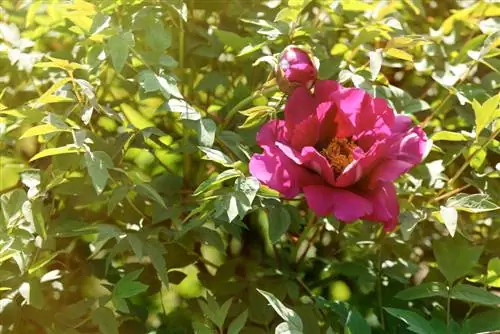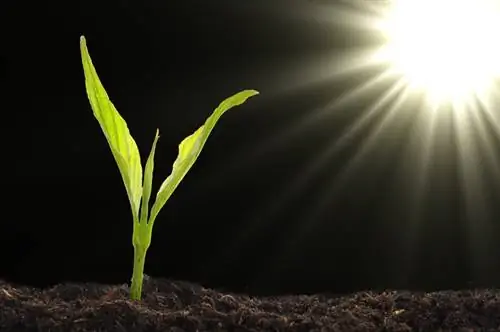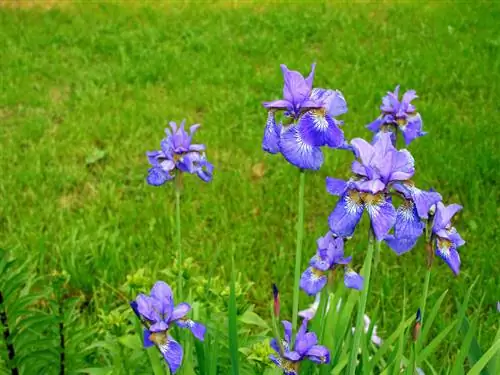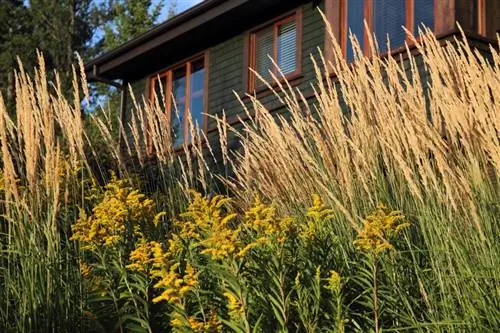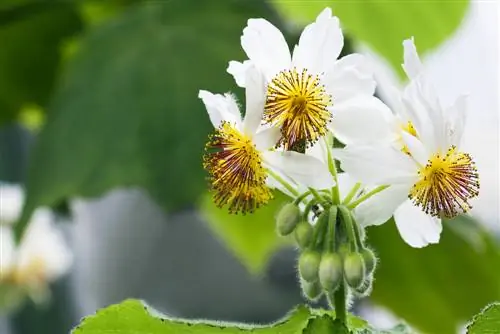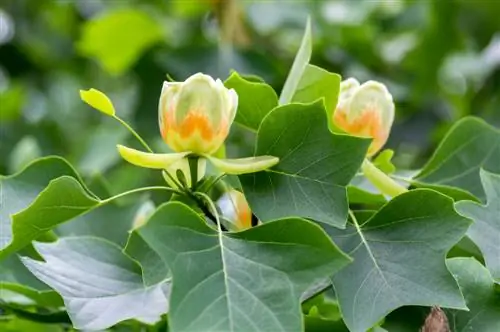- Author admin [email protected].
- Public 2023-12-25 17:45.
- Last modified 2025-01-23 11:21.
Tree peonies impress with their lush blooms. They decorate gardens and are guaranteed to attract attention. If you want to plant the garden beauty, you should know the special requirements for location and care. Suboptimal conditions quickly lead to fungal infestation.
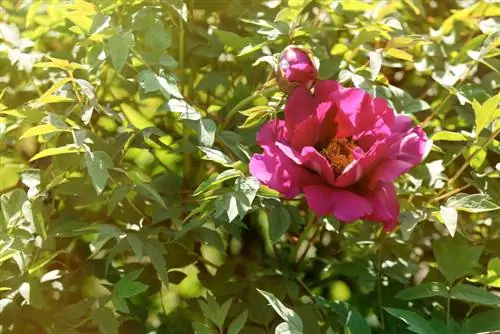
What should you know about caring for tree peonies?
Tree peonies (Paeonia suffruticosa) are long-lasting, shrub-like ornamental plants with showy flowers in various colors. They prefer warm, sunny to partially shaded locations and nutrient-rich, deep soil. Care includes regular watering, occasional fertilization and, if necessary, light pruning.
Origin
Paeonia suffruticosa, which in German has names such as shrub peony or tree peony, belongs to the peony family. Breeding has resulted in more than 1,000 varieties that are considered popular ornamental plants. Tree peonies come from China, where they colonize high mountain habitats. In this environment, the plants have adapted to extreme conditions, making the varieties very resilient.
Growth
Peonies grow like bushes and reach heights of up to 150 centimeters. Occasionally varieties grow between three and five meters high. Tree peonies do not retreat in the fall. As they get older, their shoots become woody and sprout again very early the next year. Non-lignified shoots can withstand temperatures down to -10 degrees Celsius. Woody branches have grey-brown bark, while fresh shoots initially appear reddish and later turn various shades of green. The plants are long-lived and can live up to 60 years.
leaves
The bushes develop alternately arranged leaves that are short-stemmed. Its leaf blade is pinnate several times. They consist of three leaf lobes, which are also divided into three leaflets. The individual leaflets are up to eight centimeters long and seven centimeters wide. They appear egg-shaped and are bald on both sides.
Bloom
At the end of the branches, tree peonies form large individual flowers that are hermaphrodite. They reach a diameter of between ten and 25 centimeters. The calyx is composed of five broad sepals that are colored green.
While the wild forms develop unfilled flowers with five to eleven petals, cultivated forms often have numerous petals. These varieties cannot propagate through seeds because they are sterile. Reproductive specimens develop numerous stamens that are pink to purple in color and have a white base. Their anthers are yellow in color. In the flower center sits a purple wreath called a discus.
Flowering time
Tree peonies bloom between April and June. Flowering time varies depending on location and variety. The color palette of the wild forms includes light shades such as white and pink as well as intense red and purple colors. Cultivars develop pink, red, purple, yellow or white petals.
Fruit
Fruit ripening occurs in fertile specimens in August. They develop follicles that are brown-yellow in color and have a hairy surface.
Usage
The low varieties are suitable for beautifying small front gardens or cozy corners in spacious gardens. They look good when placed alone because the bushes attract attention with their strikingly large and brightly colored flowers. Group planting of several varieties is also possible. Use varieties that bloom at different times. How to create a colorful hedge that blooms continuously between April and June.
Is tree peony poisonous?
Tree peonies are considered mildly poisonous due to the ester compounds contained in all parts of the plant. In order to suffer symptoms of poisoning, large quantities must be consumed. Possible symptoms manifest themselves as gastrointestinal problems. Nausea, vomiting, cramps or diarrhea may occur. The symptoms appear significantly more severe in dogs and cats than in humans. Even small amounts are enough to cause symptoms of poisoning in these pets.
Which location is suitable?
Peonies prefer warm locations. They thrive in both sun and partial shade. To prevent the plants from sprouting during mild winter months, they should be planted in a slightly exposed location with airy conditions. A place on a south-facing house wall is suboptimal.read more
What soil does the plant need?
Tree peonies prefer deep soil with nutrient-rich conditions. They grow on sandy loam soils and have no problems with heavy loess soils. You can plant the shrub on any normal garden substrate that has humus content and ensures good water permeability. The peony family is suitable for moist locations. The soil may be in a calcareous environment. A pH value between six and eight is ideal.
What is the best time to plant?
Peonies are planted between August and October. During this time, root growth occurs and the soil ensures warm and moist conditions. The plants can root well before the onset of winter. The potted plants offered in stores can be planted throughout the entire growing season between March and November.
Propagate tree peony
Tree peonies can be propagated by division or sowing. Propagation using seeds is lengthy and does not produce pure offspring. It can only be carried out on fertile specimens. The young plants need a few years until they begin to develop flowers.
Division
Adult specimens can be divided in spring or autumn. Dig up the root ball and remove the soil. The root ball is broken up with a sharp knife or spade. Plant the partial plants immediately in the desired location. They should be placed in the ground according to their original depth. Water the bushes well to ensure optimal soil sealing.read more
Sowing
The seeds do not have a long shelf life and should be stratified immediately after collection. The cold germs need low temperatures to stimulate them to germinate. Store the seeds in a freezer bag filled with sand in the refrigerator. The seeds should spend about two months here before they are sown on a nutrient-poor substrate in the plant pot.
Place the vessel in a place where the temperature is around 20 degrees Celsius. Keep the substrate evenly moist. After a few weeks, the seeds will have developed roots and cotyledons. Once they have grown several centimeters tall, they can be planted individually. The young plants must overwinter in a frost-free place for the first year.
Tree peony in pot
Peonies can be cultivated in pots. Use a large pot to allow the plants to spread out optimally. The bushes are fast-growing and root through the substrate within a short time. The bucket should be at least 50 centimeters deep and 40 centimeters in diameter. Use a pot made of clay, stone or terracotta.
You should pay attention to this when planting in containers:
- Create drainage from potsherds or pebbles
- Use pots with drainage holes
- Place the trunk base three to four centimeters underground
Balcony
Tree peonies are suitable for decorating balconies as long as they are not south-facing. The bushes do not tolerate heat. They prefer airy locations with a western or eastern orientation. Peonies should receive at least four hours of sun per day to ensure they bloom profusely.
Watering tree peony
Tree peonies have a high water requirement. They thrive particularly well in moist soil. The amount of watering varies depending on the nature of the soil. Loess soils and substrates with sandy and loamy components store water and need to be watered less often. Light soils require more frequent irrigation.
Make sure the soil does not dry out completely. The roots cannot tolerate waterlogging. Always water at the base of the trunk so the leaves stay dry. This measure prevents infestation by fungi or pests.
Fertilize tree peony correctly
Peonies are fertilized for the first time in their second year. They enjoy a supply of nutrients in the spring shortly before budding. You can fertilize a second time immediately after flowering. An organic fertilizer or mature compost is ideal. The nitrogen content should not be too high so that the plants are not over-fertilized and become susceptible to aphid infestation. Work the fertilizer lightly into the substrate.
Cut tree peony correctly
The shrubs do not require regular pruning. However, this measure stimulates flower formation next spring. Shortly before the leaves emerge at the beginning of the year, cut off any annoying branches and wilted flower shoots. To rejuvenate, you can cut the bushes back to 30 to 40 centimeters. Cut the branches directly above a bud so that the plant can sprout at this point.read more
How do I transplant correctly?
Tree peonies react sensitively to a change of location. Once you have found a place for the shrub, it should remain in that location. Transplanting measures can lead to poor flowering in the next few years.
Wintering
Tree peonies shed their leaves in autumn and survive with the help of their woody shoots. These survive the winter months without any problems. If the winter is particularly harsh, the plants should be given additional protection. Young plants are not yet woody. Your tissue is at risk of frost and requires special protective measures.
The ideal winter protection:
- Tie branches loosely together
- Cover made of fir branches, spruce branches or straw
- Remove snow masses to avoid branch breakage
Fungal infestation
Gray mold often affects shrubs that are exposed to warm, humid weather. Infestations occur especially in spring. The spores settle on leaves, shoots and buds. The plant parts wilt and begin to rot. Remove affected areas to prevent further spread of spores. Treat the plants with a fungicide and prevent excessive nutrient supply with nitrogen-based fertilizers.
Tip
Place peonies in the substrate at a slight angle. The sleeping eyes on the underground trunk sprout and develop ground shoots, so that the shrub grows bushy. Shrubs planted vertically develop sparse growth forms.
Varieties
- High Noon: Lutea hybrid. Bushy growing shrub. Flowers medium-sized, semi-double with light yellow petals, flower center orange-red to red. Reaches heights between 120 and 150 centimeters.
- Gauguin: Lutea hybrid. Flowers colored red and yellow, blooms in May. Up to 120 centimeters high.
- Renkaku: Suffruticosa hybrid. Foliage blue-green. Snow-white flowers, semi-double. Flowering period from May to June. Up to 150 centimeters high.
- Shima Nishiki: Suffruticosa hybrid. Flowers purple-pink and white-striped. Up to 130 centimeters high.

